
While Ford of England first marketed a Capri model in the early ’60s, the Consul Classic Capri, the first one offered in the United States appeared in 1970 and was sold by Lincoln-Mercury dealers. Often called a ‘Mercury Capri’, it really wasn’t. It was just the Capri, as borne out in all advertising and brochures. Sporty, affordable little imported coupes were hitting their stride in the early ’70s, and Ford wanted in on it.
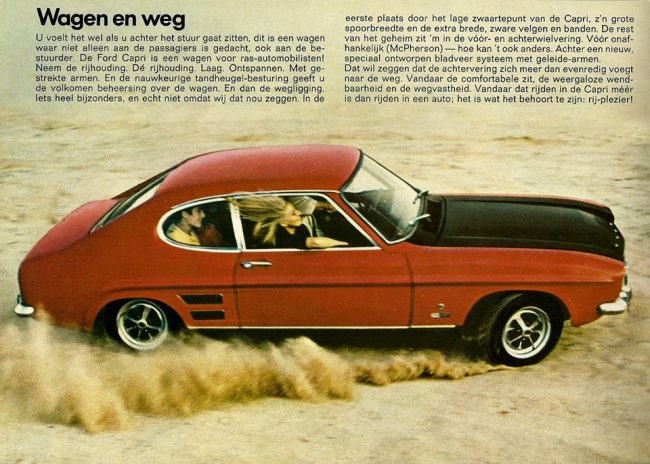
By the time the Capri came to the US market, insurance premiums were beginning to have an effect on sales of cars like the Mustang, Javelin, Barracuda and others. In short order, your choices for coupes were down to two basic types: a big, landau roofed cruiser like the Monte Carlo or Grand Prix, or a small, sporty coupe such as the Capri, Opel Manta or Toyota Celica.
The Capri was built by Ford of Germany and introduced as Europe’s answer to the Mustang: a sporty coupe based on a bread-and-butter, high volume line of cars. While the powertrain was largely derived from the Cortina, the Capri also had much in common with other European Fords such as the Ford 20M and 26M two- and four-door sedans.
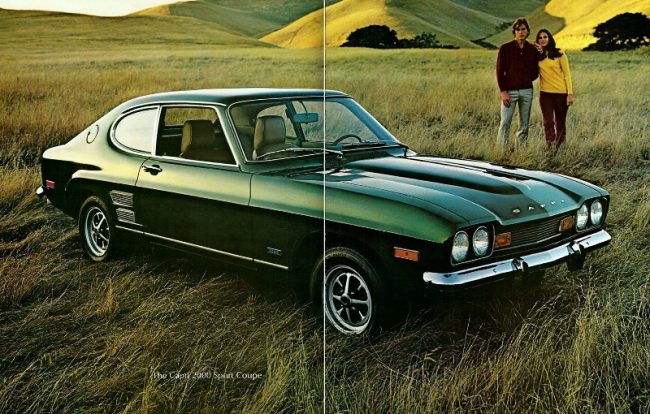
While the Capri had semi-fastback styling, it was not a hatchback, retaining a conventional trunk lid. Its styling echoed the Mustang to an extent with its long hood, short deck proportions. It even featured similar faux air scoops in the rear quarter panels.

Considering how the Mustang was growing (albeit largely visually, its overall length wasn’t drastically greater than the ’65), by the early ’70s, it would not really be competing with the sporty, svelte German Ford. Though it sought a market not unlike that which drew folks to the original ’65 Mustang.
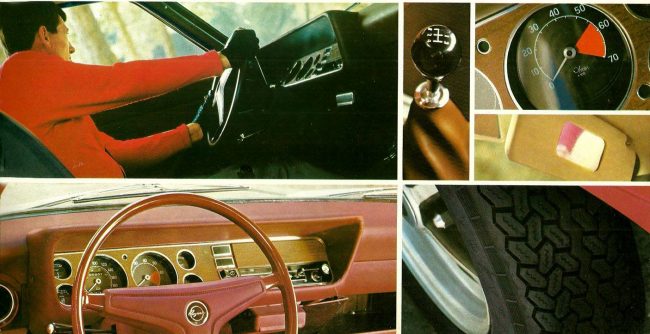
Like other German and English Fords of the time, Capris featured a front-engined, rear wheel drive monocoque body with front disc and rear drum brakes. It had an independent front suspension and semi-elliptic three-leaf rear suspension.
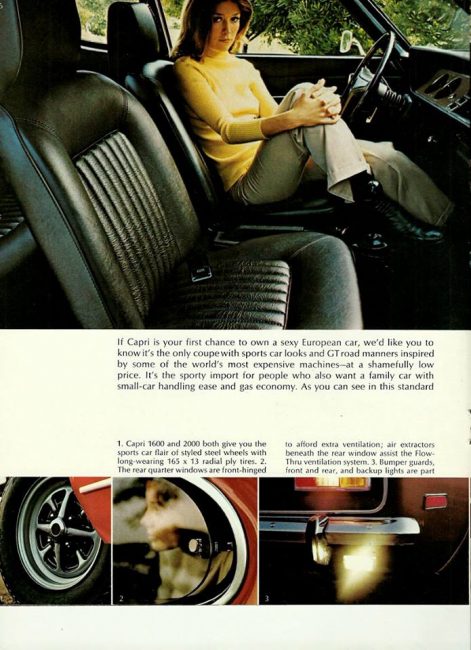
A four speed manual was standard equipment, with Select-Shift automatic an option. Early US-market Capris made do with a sub-100 hp 1.6L inline four cylinder engine that wasn’t really anything special, performance-wise.

Things got more interesting the following year, when an OHC 2.0L four cylinder became available. In 1972, the Cologne-built V6 was added as well, providing sprightlier motivation for those who wanted it. Regardless of which engine they had, the “Sexy European” Capri was a hit in the States. It actually became the second-best selling import after the VW Beetle, no mean feat.
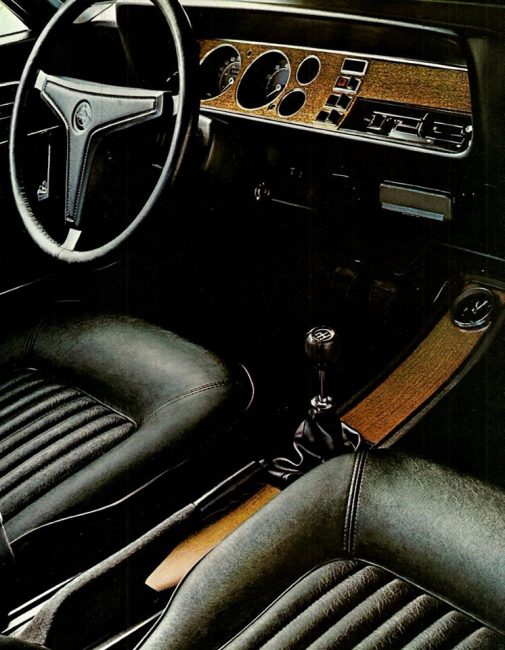
1973 Capris got a minor facelift with a new grille and 5-mph front bumper. It still retained the slim chrome bumpers, though the front one was now positioned much further from the body. That changed in 1974, when much more substantial bumpers were added front and rear. They still looked better than many other 1974 models, however, as they wore body-colored plastic covers that made them look less tacked on.
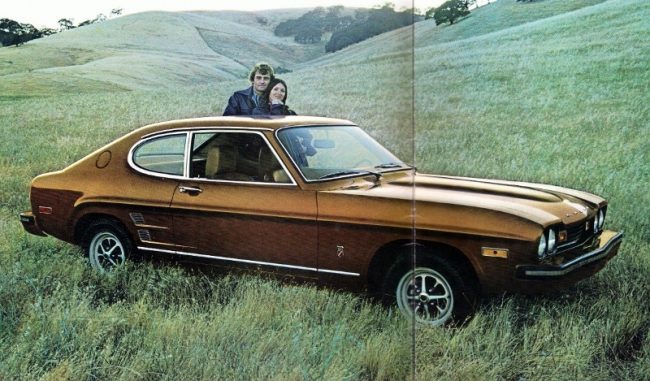
By ’74 the Capri came in two varieties, the four-cylinder 2000 and V6 2800. In addition, V6s added blackout trim below the chrome side trim and on the rear taillight panel, plus V6 badges on the front fenders. The Rostyle wheels were still in evidence. It never occurred to me how much they look like MGB wheels. Funny, considering they are virtually identical.
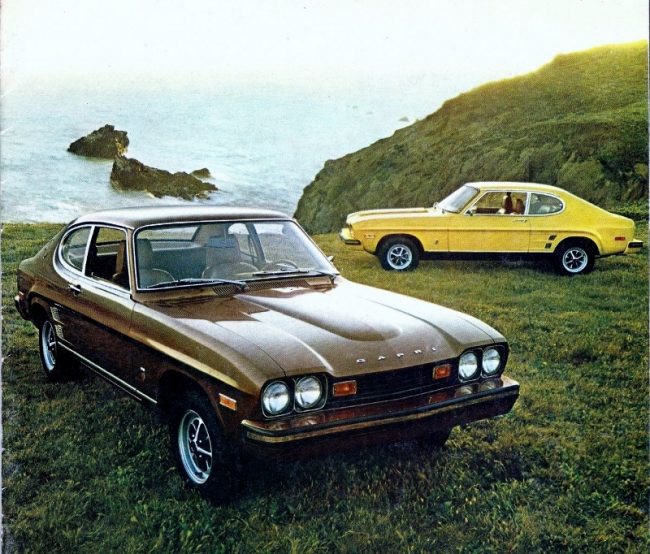
Thanks to the enhanced bumpers, Capris were now 174.8″ from stem to stern, though the wheelbase remained at 100.8 inches. 1974s came in eight colors, including Yellow, Red, Medium Green Metallic and Medium Brown Metallic – perhaps better known as ’70s Brown. Capris were not bargain basement equipped, as all cars came with standard bucket seats, pop-out rear windows, bright bodyside and window trim, and color-keyed carpeting.
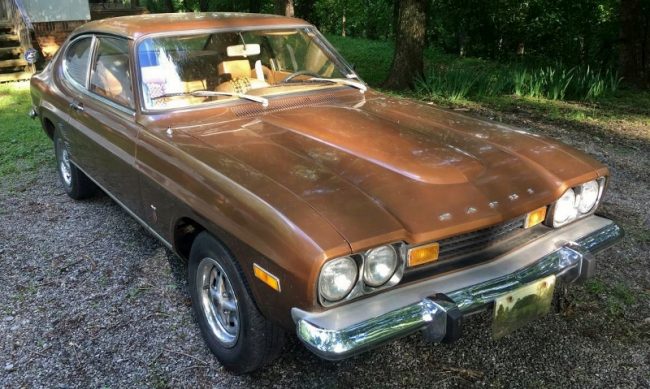
As mentioned in previous articles, my Dad was a dram shop insurance investigator in the ’70s, and as a result he got a company car because of all the traveling. His first one was a ’73 Gran Torino sedan, in copper with a brown vinyl roof. He was more used to sporty little cars, having owned several Porsche 356s and a Triumph TR-5. That Torino must have been kind of a drag, because just one year later he was allowed to get a sporty yellow ’74 Capri V6 with four speed from Bob Neal Lincoln-Mercury in Rock Island.
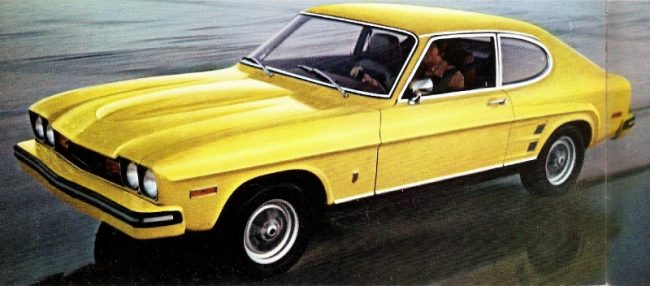
It must have been a breath of fresh air after the undercover detective special that was the Gran Torino. His Capri had the “terra cotta” colored interior and a four-speed manual. Unlike many Detroit cruisers of the time, the Capri had full instrumentation instead of a just a gas gauge and speedometer. This was also the car my folks took on their honeymoon. They drove it to Pikes Peak, and there is a picture somewhere with Mom, the Capri, and the mountains in the background.
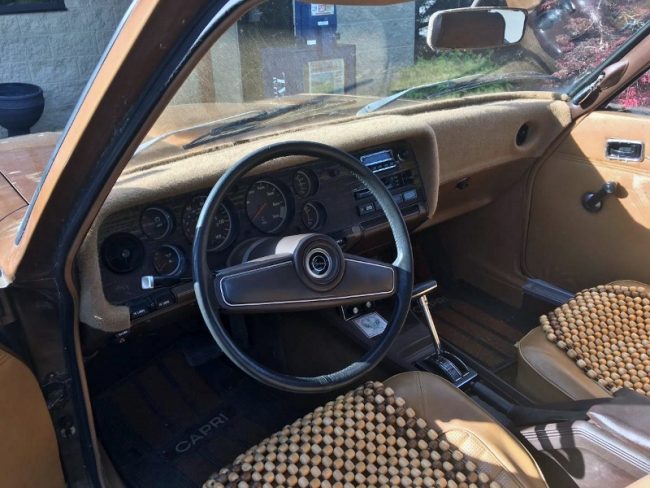
One funny story involving the Capri happened one day when he was driving back to Rock Island from Geneseo. While he was on the highway, someone passed him and cut him off. Naturally, this ticked him off, so as he was shifting into second, he brought the gear lever back a little harder than he should have, and the entire lever came off. Now the car was stuck in second gear with no way to shift it.
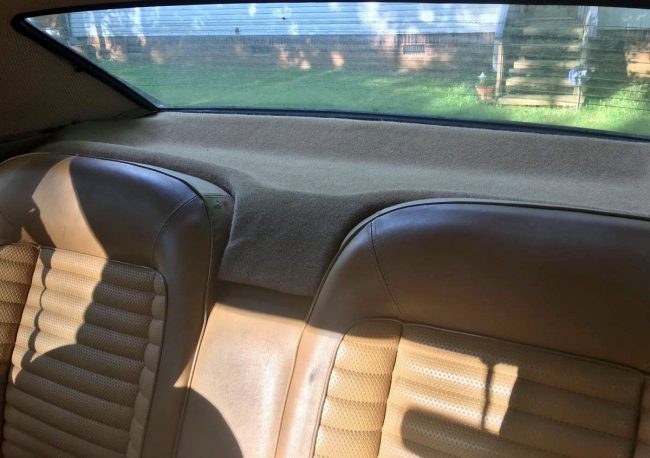
He parked the car on the shoulder just outside of Geneseo and hitchhiked to Porter’s, a little hardware store in Hampton, IL, where he called Mom and told her to please come and get him. The Capri got towed in to the dealership, and was fixed in short order. Things like this can only happen to my Dad.

The Capri was none the worse for wear, and eventually Dad bought it from the company for my Mom when her Diamond Blue ’68 Mustang started getting really rusty. One day she was driving the Mustang, looked down at the floor and saw the pavement go by. Time for a new car! She put an ad in the paper and the Mustang was sold to a guy who seemed nonplussed at the rust and happily paid up and drove it away.
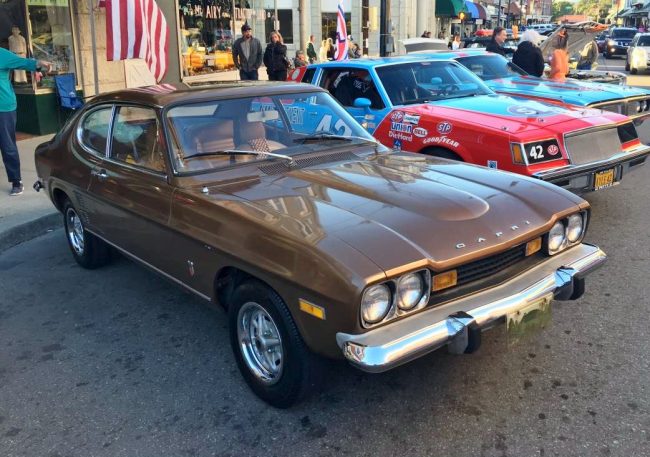
Our featured ’73 model, in oh so 1970s metallic root beer brown over terra cotta vinyl, was recently spotted by your author on Winston-Salem CL. It appears to be in extremely nice shape, with a claimed 50,000 miles on the clock. After seeing this ad, I did a search for Capris online, and very, very few popped up. And most of them appeared to be project cars. Not a lot of survivors here in the States!
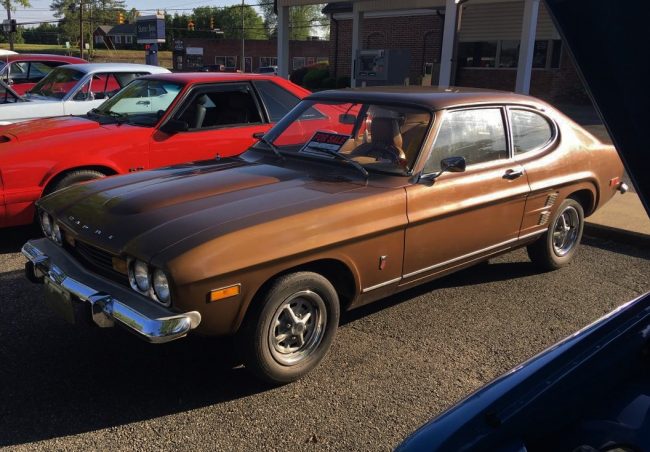
I haven’t seen a live Capri in years. In fact, the last one I recall seeing was a faded red one in a junkyard about 25 years ago. I was with my Dad and my brother; Andy and I collected old car emblems, and Dad indulged us from time to time by taking us to U Pull A Part in Milan. I still have the rear deck “Capri” script from that car in a drawer somewhere.
After the 1974s, the Capri II came out as an early 1976 model (there were no 1975 model Capris in the US). It had new front and rear styling and smoother flanks, finally eliminating the fake quarter panel extractor vents. The biggest news, however, was a hatchback. Sales did not really take off though, as the exchange rates of the German-built import were making it prohibitively expensive for many pocketbooks. The last German Capris were imported in 1977, with some leftovers sold as ’78s. For 1979, a new Capri would be essentially a Mustang, with a domed glass hatch and some unique sheetmetal and trim.
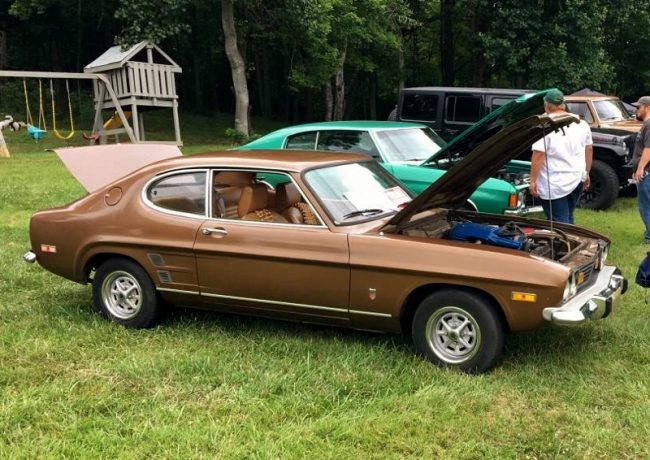
As for our Capri, Mom eventually got tired of driving a manual transmission. Her first three cars (’59 Dodge, ’60 Impala and the ’68 Mustang) had all been automatics.
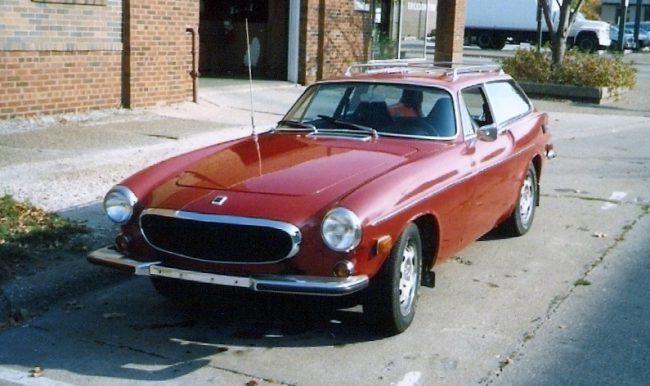
The Capri was traded in on a 1973 Volvo 1800ES with an automatic transmission. So started my parents’ long association with Volvo. Which continues to this day with a ruby red XC60 T5.









25 Comments
What a revelation the 60 degree V6 must have seemed to our European friends where hopping up usually just involved dual carbs on the standard small sedan engine. With the low weights involved the V6 was able to match 302 V8 Mustangs of the day. The Cologne V6 proved very influential at GM had it showed how a smooth 60 degree V6 could play V8 in light economy minded front drives. Something that had eluded the designers of such allegedly advanced front drive economy sedans like Lancia Betas and Renault 16s with their embarrassingly small engines that were slow even without emission controls at home, and unsellable in the USA. Thanks Tom.
Do you know that Lancia introduced the world’s first production V6 in 1950? That it had a 60 degree V between the cylinder banks? That the 1976 Lancia Beta Coupe 2000 had a top speed of 117 mph and achieved 60 mph in 9 seconds, making it about as fast as any big block Detroit gas guzzler produced that year, and faster than any X/11 produced in the next half dozen years? The reason was because it was light for having no real bumpers or safety features, and because Europe was still a continent of gross polluters, freeing up about 35 more horsepower than the federalized car Lancia 1800 had. What they did care about is fuel consumption, far more than human life, and that is why the Beta had 1.6 and 2.0 liter engines in Europe. The Lancia V6 went out of production in 1970 because of fuel prices, not because Lancia couldn’t design engines as well as GM or Ford.
The V6 were not in Fiat based family Betas but much more expensive things pre Fiat. The American Beta was slower than a lima Pinto. Did they still have an engineering department after the Fiat takeover? Using just smaller engines allows for much lighter duty parts that still didn’t seem to last. Customer be dammed.
Engine displacement used to be a very important factor in car ownership taxes in countries such as France and Italy, hence the smaller engine sizes. Everything over 2,0 litres would be taxed out of existence in the home market so yes, you would rather have a Lampredi engine with DOHC and a twin Weber setup in your Beta, or a 1.6 in your Renault 16.
Agreed American V6’s have been very good for a long time and a safe bet in most cars they came in.
These things were all over the place in the early to mid 70s, and the only Mercury of the time that wasn’t a bloated boat. I always thought they had a much nice interior than a contemporary Mustang. But apparently the love affair with the Capri was not Mustangest in the US as they truly have disappeared from the streets and cars and coffee gatherings, although I think they are still collected and cherished in the UK.
They had short life spans in the US, rust was hard on them, most of them were probably scrapped by 1982. The earlier V6 models had a head issue or something that also killed them fairly young. I remember these looking really cool in the ads I’d see when flipping through my parents stock of old cira 1968-1972 LIFE magazines in the garage. The wood paneled dashed with the full gauges and the pleated pleather seats gave it a real sports car vibe
In central Virginia, they were still frequently seen well into the mid and late ’80s, although they were often just sitting in driveways and service station storage lots. The problem wasn’t that they were any less robust than other FLM cars of the era, but that Ford didn’t continue replacement parts support for them when they stopped importing them. It was a practice Ford also used to shaft their US Cortina customers, Fiesta customers, and Merkur customers. Theses days the internet connects people with obsolete parts, but at the time it killed their usefulness as daily drivers.
In 1977 I bought a used 73 model with the 1.6 from a private party. The odometer showed somewhere in the neighborhood of 55K if I remember correctly. Approximately a month after I bought it, it quit charging. A local starter/alternator shop quoted approx $75 for a replacement alternator. The problem was with the voltage regulator, which was built into the alternator( my first experience with that). I was quite short of funds, so the shop sold me a Ford regulator, and showed me how to wire it in. Another couple month went by and I went out to my car at lunch time and discovered my battery was dead. When a buddy went to jump me off, the outboard headlights (the high beams) came on. As a temporary fix, I just unplugged them. About a week later on my way to work, It started to lose power and then overheat. Pulled into a parking lot and shut it down. Next day towed it home and tore into the motor. Found a blown head gasket, but also a nearly burnt thru #3 piston. Pulled the oil pan and the rod cap on that piston and found the rod bearings were worn badly. Dropped a main cap and found the same. Ended up going and buying a motor from a wreck and putting it in. When I went to fill the radiator, it leaked in 2-3 places. I said some bad words, hooked up the battery and the other 2 headlights came on. After swearing for about 20 minutes, while repeatedly kicking the POS, I ended up starting it and pulling it out of the garage. Pulled out the battery, removed the license tags and stuck them on a recently 73 Datsun 1200. I refused to touch that money pit POS Capri for a year, in fact I put a tarp over it so I wouldn’t have to look at it. I ended up selling it to a coworker, for 1/3 of what I had invested. He bought it, even after hearing about all the problems I had. He jury rigged a few things and drove it for few months before other problems started to trouble it. He too finally gave up.
If other Capri’s of that vintage had similar issues to what I had, that might explain while there are so few around these days. If I hadn’t just put a fair amount a money into mine, I would have happily torched it and danced around the burning turd.
The price difference in between a “regular” domestic and something from one of the imported brands was shocking sometimes. I’ve heard the story from an older friend if mine who had a similar issue with another “captive import”, he had a flasher go out on a $100 beater 1966 Opel Kadett around 1980, out of curiosity he checked with Blake Buick-Opel on the price if a new flasher and he was quoted something like $65 for the flasher…..more than half the price of the beater Opel.
IIRC, I could get a rebuilt GM or MOPAR alternator for under $20 at that time. The price difference was eye opening.
As a child growing up in Manhattan my family didn’t have a car. We did however go to the beaches on Long Island for the summer and my parents would rent different cars on weekends to get there. One of my favorites was the Mercury Capri. It was much better looking in my opinion than the Ford Galaxy 500 we typically got and the interior was quite comfortable for a small child sitting in the back. I obviously didn’t drive it so I couldn’t tell you if it was fast or slow but the suspension seemed to handle the potholes on Jamaica boulevard in Queens quite well. It also seemed to fit in with the Jaguar E-types and Shelby Mustangs at the beach we frequented. I thought it looked cool and it was my first experience with pop out rear windows and my own bucket seat in the back. It seemed quite expensive to me and my friends at the beach admired it as well. It brings back fond memories and it appears lucky that we didn’t own one.
When I was growing up my neighbor had one of these: silver outside, black vinyl inside, growly 2.8 liter V6 and manual transmission. I thought it was the sexiest thing around, undersized MGB wheels and all. I hoped that by the time I got to be driving age there’d be an affordable used one, ideally root beer brown with tan interior, but it was not to be: they were everywhere one day, and vanished the next. Same with the Porsche 924, MGB, and Mazda RX-7, come to think of it: it’s like all the long-hood imports were raptured.
Oversteer must have been a real thing with these cars. As I recall the rear suspension only had 3 inches of travel, presumably requiring a firm spring rate…in the rear of a rear wheel drive car. Whee!
The Brits adored the Capri and from 1978-1988 a Mark III model was made mostly for them. It’s a tasteful evolution of the styling, with the hood smoothed and lengthened to shade the headlamps under eyebrows, wider pepper-pot wheels, a rear spoiler, and Mercedes-style slatted taillights. Engine choices ranged from the 1.6 four to a 3.0 six. Those with money to burn could go for limited-edition widebody turbo models that were stupid-fast for the day (how’s 0-60 in 6.7 strike you in 1984 England?). But the arrival of hot hatches — cheaper to build and buy than the German-built Capri — ultimately doomed the car.
When I was a kid my friends brother traded a 68 Ford Torino convertible for one of these. He didn’t keep this too long. I loved that Torino.
A while back Practical Classics did an article comparing an English GT Capri with a 100 gross horsepower dual carb Kent 1.6 against a Celica 1.9, a Manta 1.9, a Marina TC 1.8, and a Viva. Naturally the Marina and Viva being not lowered and more sedan based came off worse and they liked the Manta best. I forget what weight they quoted on the Capri but with small bumpers and the Kent it was light. Given all the hopping up of the Kent, I was surprised it didn’t come off better since overseas folks are so elegantly minimalist and those Chevy based 1.9s in the Celica and Manta are hardly sporting engines. Even the English seemed to wonder why bother with sporting four Capris when there was a really fast V6 to be had.
Sidebar, our friends at Toyota were claiming over 50% more power for their 1.9 versus the practically cousin 1.9 engine in the Manta. Yet with similar gearing and weight the two cars acceleration was almost identical. Toyota must have been the inspiration for Hyundai’s later optimism regarding the output of their fours. Someone should cue Rock Hudson to start singing “You are my inspiration, Mr. Toyoda”.
https://www.flickr.com/photos/triggerscarstuff/8506824297/in/album-72157632856974074/
The Japanese were still publishing gross hp ratings when the Brits had switched to net hp ratings. Also, the gross hp listed by Toyota was 20% more than Opel’s net rating. Finally, the cam-in-block Toyota 1.9’s head looked more like something off a Chrysler hemi than it resembled anything GM ever made. Opel’s fours were ‘cam-in-head’ at the time. Thank you for making the world a more misinformed place.
Opel in 1973 for 1.9 75hp, Toyota claimed 108hp, both in USA when nobody was supposed to be still using gross numbers. Acceleration the same. Sing it Rock.
You two are like an old married couple. 🙂
Ready to die within days of each other?
Mom bought a pair of these Capris in the 1970’s for her and my Step Father (R.I.P. Lawrence), they were identical and brandy new, I visited and Moms asked me to drive them to Maine for a weekend, at 85 MPH on the thruway the crappy firestone “maypop” 500 tire goose egged and blew right after I puled over, I was able to watch the large goose egg inflate out of the side of the tread & sidewall before it popped loudly .
I remember the car to be O.K. at the time but nothing I would want .
-Nate
This, not the Pinto, should have been the basis for the downsized 1974 Mustang. It could have been adapted to the American market, with minimal changes (one hopes, better than the Fiesta became the Escort) with the platform engineering already done. And the derision of the time for the MusPinto Too would never have been.
The debate among purists was, Pinto or Maverick as basis for the 1974 Mustang. But here, there was a car that WAS the Mustang. Just some styling tweaks, with an “intake” grille with headlights outside it; and minor changes in the roofline…and the Gas Crisis Mustang is READY.
And it would have sold. If made in America, it would have avoided the d-mark valuation price skewing; would have been able to say, “Made in ‘Murrica” and have been an alternative to either of the boring Ford compact/sub products.
I doubt there was much cross shopping between Capri and Mustang either in 1973 or 1974. I think the DM issue was more about profit margins then sales. The challenge was to get the import buyer into a Mercury dealer, even for a car that goes without a Mercury emblem. This while they will happily scout some fly by night import dealer at the edge of a gas station Like todays lefty staying at one of Trump’s hotels. buying a Mercury just seems wrong to them.
Remember inversely the Probe was made in Flat Rock and Mustang (domestic) people said no way. That wasn’t just fwd versus rwd.
I was in love with these cars when I was a teen. They were not inexpensive back in the day, however. Shopping for a new car with my brother back in 1978 opened my eyes on this matter. By the time I was old enough to buy and drive my own car, the original cars were expensive, rusty time bombs. The Fox-body based domestically-produced 1979-86 Mercury Capri was a great replacement for this car, even with it’s own faults.
It’s great to see some of these cars now, however.
The Fox Capri was hit-and-miss – IIRC, they shifted to the domestic in-line six when they had supply issues with the Cologne V6. That probably made a big difference in the overall feel of the car – cast-iron sixes are HEAAAVY. So, you had to dig deep to find a V6 used, or hope you were in the right place, right time, if a new one with a V6 was available.
The 302 V8 was so choked back then, it wasn’t worth the weight and cost.
I had watched these little Germans from a distance, from when they started coming in. They were popular in my neck of the woods. I liked the originals (as a 12-year-old) and didn’t like the battering-ram bumpers. The refresh made it worse; and so did the DM-Dollar exchange rate.
They were probably good cars, but not good enough to spend more to pick one over a Fox-chassis MusCapri.
Yes, the straight six substitution was one of the faults I alluded to in my earlier post. IIRC, the Cologne V6 was a pricey option over the Lima motor and the V8 was much more than either on the Fox body. The early 1980’s shortage of Cologne V6 forced the heavy, under-performing 3.3L Falcon six to be substituted in. Really, after the loss of the Cologne V6, the Fox bodies never had a decent six again.
I think the other fault were the “stripper” versions that the Fox body offered; as they were never as inexpensive as their Mustang counterparts. The German-built Capris were pretty well optioned in general and when folks went to look at a Fox body Capri, they saw an attractive price but with a de-contented car. It didn’t take long until the Capri was an also-ran. At least the mid 1980’s 5.0L versions benefited from all of the improvements that the Mustang brought.